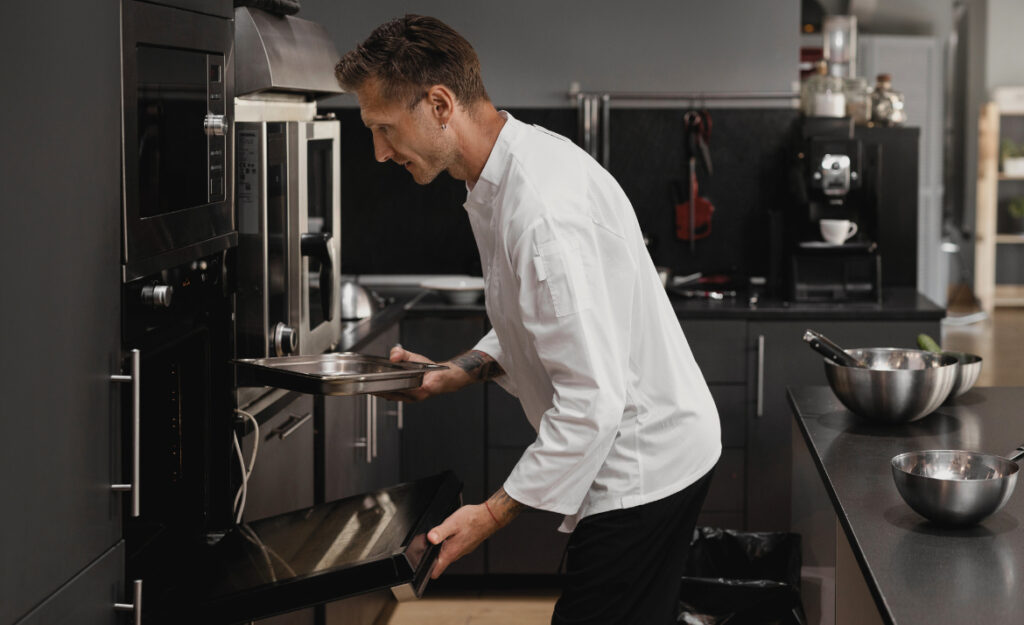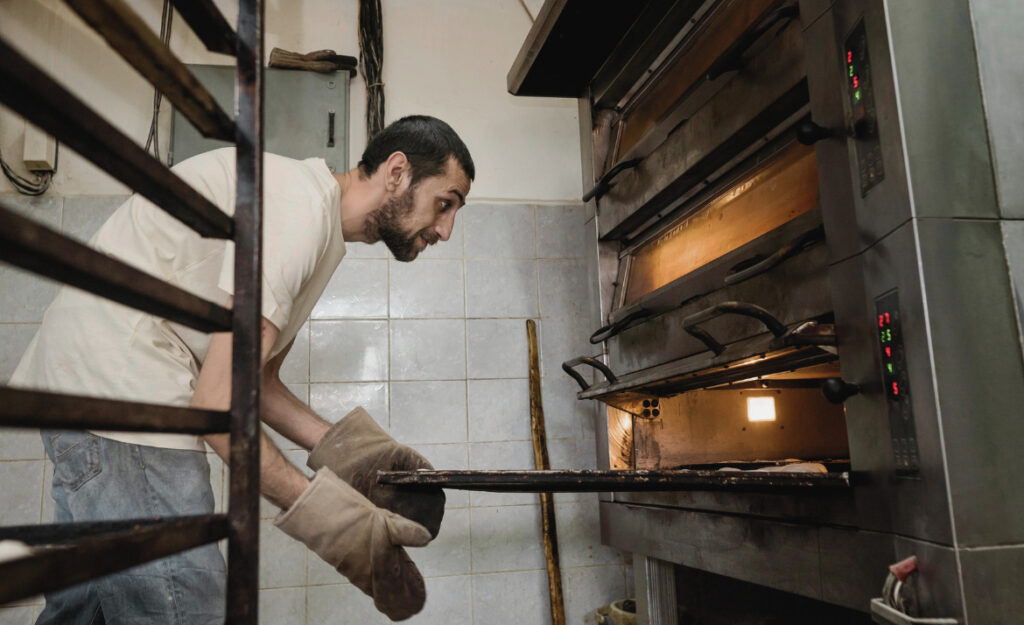
Every industrial kitchen team faces the messy remains of roasted meats or baked dishes. Tackling grease, grime, and burnt-on spills can exhaust anyone, yet oven cleaning hacks known by professionals save both time and money in this environment.
Dirty ovens do more than slow your kitchen: they impact food quality, safety ratings, and staff morale. Clean ovens bake more evenly and cut down on lingering smells or harmful smoke. Efficiency rises, risk drops, and food tastes better when ovens shine.
Ready to transform your commercial kitchen’s cleaning game? As you read on, you’ll pick up smarter routines, proven tricks, and practical shortcuts. Let’s uncover the pro strategies, one section at a time.
Reduce Downtime with Spot-On Daily Maintenance
Integrating brief daily oven-cleaning tasks prevents residue buildup and keeps kitchen equipment safe. Staff finish faster and ovens stay pristine throughout heavy cooking shifts by following a maintenance checklist.
Establish real routines with clear instructions. For instance, when the shift changes, one person swipes racks with a damp cloth while another checks for spillover. This teamwork preserves efficiency.
Daily Routines for Line Cooks
Assign each line cook a role. One wipes up spills right after use, while another empties crumb trays. These simple divisions reduce arguments and speed up cleaning at shift’s end.
Quick clean-up avoids the chore snowballing into a daunting, time-consuming task. Think of it as rinsing a pot before sauce hardens—much easier than chiseling off dried debris the next morning.
Rotate duties weekly. This keeps everyone attentive and prevents burnout. Announce rotations at morning standup so no one’s surprised and standards stay high through every shift.
Keeping the Oven Exterior Presentable
Staff use a microfiber towel and diluted degreaser each evening to shine handles, control panels, and oven fronts. Remind them streak-free surfaces reflect your team’s pride and attention to detail.
Treat these areas like the showroom window: customers and health inspectors notice every smudge. When a streak appears, staff should reach for that towel, just like straightening chairs after service.
Staff set a goal to wipe down external surfaces in under three minutes. Use a timer or play a favorite upbeat song for motivation during closing routines.
| Task | Who | When | Takeaway |
|---|---|---|---|
| Wipe racks | Line cook | Shift change | Prevent baked-on residue |
| Empty crumb trays | Prep crew | End of service | Reduce carbon smell |
| Clean exterior | Closer | Nightly | Boost presentation |
| Temp check | Lead | Morning | Spot heat irregularities |
| Initial quick wipe | Anyone | Post-spill | Stop spill spreading |
Apply Pro Techniques for Burnt-On Messes
Using targeted oven cleaning hacks lets your team tackle even baked-on cheese or burnt gravy with less sweat. It’s about knowing which tool to grab and why.
To tackle sticky residue professionally, you want the right cleaners, gentle abrasion, and effective timing. Pre-soaking spots saves scrubbing efforts later. It’s like letting a casserole dish soak while you prep salads.
Smart Scrubbing and Soaking
Sprinkle baking soda on stubborn stains, add a bit of water, and let it sit for twenty minutes. The mixture loosens grime so you spend less elbow grease on removal.
Always scrub with a plastic scouring pad, never steel wool, to avoid scratching oven walls or racks. Instruct new hires: “Easy does it—scrub like you’re rubbing sunscreen, not sanding wood.”
If residue persists, apply a moderate amount of white vinegar directly atop baking soda. The fizzing signals active cleaning—staff see results before their eyes, boosting motivation to finish the job.
- Start every deep-clean by unplugging and cooling ovens completely: prevents injuries and protects sensitive electronics.
- Sprinkle baking soda on burnt spots: it draws out moisture and makes grime lift up when wiped away, cutting scrubbing time.
- Use a warm damp cloth to apply gentle pressure on door edges: it removes sticky fingerprints without risking glass scratches or seals.
- Treat racks separately in a utility sink: they soak better and can be handled vigorously without damage, then air-dried before reinstalling.
- Finish with a vinegar rinse: this kills odor-causing bacteria and leaves metal surfaces smelling neutral instead of acrid.
Each staffer learns the baking soda-vinegar sequence, cutting wasted time searching for strong chemicals or replacements.
Handling Glass and Seals with Care
The oven glass and gaskets need gentle handling. Dab a cloth in diluted vinegar for glass. For seals, avoid harsh scrubbing—run a cloth along the edges so food bits don’t disrupt the seal.
- Remove crumbs with a soft brush, not vacuum: this avoids tearing gaskets or damaging sealant.
- Lift glass panels if possible: clean edges for clear visibility, key for high-volume kitchens.
- Mark your calendar quarterly for deep-cleaning seals, keeping energy efficiency up and defense against surprise breakdowns strong.
- Replace worn or cracked seals promptly—never push them to the limit as even one gap lets heat escape, raising energy costs.
- Teach these steps during orientation so every new team member follows a standard protocol from day one.
Attention to details like these means you’re not just fighting grime—you’re preserving the equipment’s efficiency and lifespan every shift.
Optimize Steam Cleaning for Heavy-Duty Oven Cycles
Manual cleaning isn’t the only strategy. Smart commercial kitchens use steam cycles and moisture-based oven cleaning hacks for consistent success. Steam cuts through grease without harsh fumes crowding the kitchen.
Steam cycles combine water and heat: this technique impresses newcomers. The observable steam fogs oven windows, leaving even corners glistening when wiped down soon after. It’s labor-saving and safer for staff.
Sequence for a Steamed Clean Interior
Always empty the oven, then fill the tray or a heat-safe pan with water, adding a dash of lemon juice. The lemon scent lingers, impressing staff and diners alike.
Set ovens to their highest cleaning or steam setting, allow steam to build for at least 15 minutes, then turn off and cool slightly. The softened debris comes away smoothly.
Use a thick woven towel to wipe down interior surfaces, including fan covers. Apply extra pressure at the back corners, where splatter collects and escapes daily notice.
Adapting Steam for Unusual Shifts
If a delivery delays prep, use the waiting time for a quick oven steam. Announce “Oven’s running a steam cycle,” so no one interrupts or tries to load new trays mid-clean.
Adjust steam sessions to match closing days. When the kitchen’s quieter, allot extra time for a double cycle, especially before inspections or major catering gigs.
Post-cycle, assign one person to check walls and seals for loosened grime. Use this mini-inspection as a second line of defense against surprise debris next service.
Trust Eco-Friendly Solutions Without Sacrificing Cleanliness
Sustainable industrial kitchens switch to low-impact oven cleaning hacks for health, safety, and the environment. Eco-solutions compete with harsh chemicals, proving you don’t have to trade clean for green.
Go-to options include baking soda, vinegar, lemon juice, and enzyme cleaners. Not only do these cut costs, but they also keep vents clear of chemical scents, protecting both food quality and workers’ lungs.
Scenario: Swapping Chemicals for Enzymes
Lead chef says, “Let’s try the enzyme cleaner tonight—it’s less harsh.” Staff notices there’s less coughing, and the oven shines. Include the change in cleaning logs.
Kitchen managers check eco-products for certifications. When ordering supplies, choose the solution with the fewest warning labels for routine use, reserving potent chemicals for emergency deep-cleans only.
Educate staff: less residue means less rinsing, speeding up closing duties and ensuring the next batch of bread or cake rises without flavor contamination.
Delegate and Track: Systems That Scale in Big Kitchens
Assigning and tracking tasks helps big industrial kitchens keep cleanliness standards high, even with large or rotating crews. Digital or analog checklists clarify expectations and ensure nothing is skipped.
When everyone sees the plan posted, even new hires know what comes next: “I wipe trays; you check hinges.” Tracking keeps teams accountable.
Set Up a Shared Cleaning Calendar
Hang a printed monthly calendar in the breakroom. Each day highlights specific oven cleaning hacks—from ‘door seal inspection’ to ‘fan blade dusting day’—so nobody guesses their job.
Each team member initials when a task is done. This simple step ensures night shifts don’t double work, which can breed resentment, and confirms thoroughness for bosses and inspectors alike.
Every Friday, managers review the calendar, updating any omissions or shifting staff assignments. Immediate feedback means no one waits a week to fix gaps, maintaining high standards throughout the month.
Bonus Tactics for Speed and Safety in Large-Scale Operations
Apply time-saving oven cleaning hacks when the kitchen’s busiest. These tricks keep teams moving while reducing risk—key for catering, volume baking, or around-the-clock facilities.
- Keep mop buckets and towels stocked between stations: no one wastes time running across a large kitchen for basics, so clean-up happens fast.
- Practice “clean as you go”: after each batch, quickly wipe down hot spots. It’s like brushing crumbs off a counter—done in seconds, it prevents hardening messes.
- Rotate tools: assign one mop, one brush, and one towel per oven bay, reducing cross-contamination and keeping station-specific gear clear and ready.
- Train on emergency “burn protocol”: know how to cool and treat a hand or arm if someone hits a hot spot mid-clean. Safety knowledge saves pain and downtime.
- Schedule midday resets: set timers for quick group wipes and checks mid-shift, so grime never sneaks up by day’s end. It’s preventive, not punitive.
By normalizing these tactics, high-performing teams breeze through post-rush cleanups without sacrificing safety or cutting corners.
The Professional Payoff: Why Clean Ovens Keep Kitchens Thriving
Effective oven cleaning hacks drive quality, speed, and reliability in industrial kitchens. Each practical tip and team system prevents emergencies, cuts utility bills, and lets your staff focus on food.
Staying vigilant about standards preserves equipment, impresses health inspectors, and reassures commercial clients. Clean ovens don’t just bake better; they become the cornerstone of any serious kitchen’s reputation for excellence.
Adopt these pro-tested routines, adapt systems for your exact workflow, and pass along your favorite trick to the next crew. As each shift takes pride in a gleaming oven, everyone benefits—staff, guests, and business alike.
Frequently Asked Questions
How can I remove burnt cheese from oven racks in an industrial kitchen?
Soak racks in a commercial utility sink with hot water and baking soda for 30 minutes. A sturdy plastic brush then removes residue. Rinse thoroughly, dry, and reinstall to prevent rust or flavor contamination.
What’s the safest way to clean commercial oven glass without streaks?
Use a microfiber towel dipped in diluted vinegar solution. Wipe in small circles while the glass is cool. Buff dry with a fresh towel for a streak-free result, ensuring no water drips into controls or seals.
How frequently should oven gaskets be inspected and cleaned?
Inspect gaskets monthly, but quickly check for food bits or debris during each wipe-down. Deep-clean quarterly, replacing damaged or cracked seals immediately to maintain optimal energy efficiency and tight oven closure.
Are steam cleaning cycles safe for all commercial ovens?
Most industrial ovens offer a steam cycle, but always consult the manual first. Ensure all removable parts are out and allow the oven to cool slightly before wiping down immediately after steam to prevent burns.
Which cleaning products are considered eco-friendly for industrial ovens?
Baking soda, white vinegar, lemon juice, and certified enzyme cleaners are effective and safe in most kitchens. Always check compatibility with oven material and local codes. Reserve harsh chemicals for deep-clean emergencies only.



